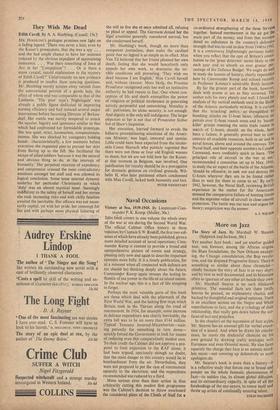Naval Occasions
Victory at Sea, 1939-1945. By Lieutenant-Corn- mander P. K. Kemp. (Muller, 30s.) 'hilts btiok.covers in one volume the whole story of the war at sea during the Second World War. The official. Cabinet Office history in three volumes; by Captain S. W. Roskill, the first two vol- umes of which have already been published, gives a more detailed account of naval operations; Com- mander Kemp is content to provide a broad and comprehensive picture of events and strategy, pausing only now and again to describe important episodes more fully. It is a timely publication, for at a moment when all connected with defence are ,(or should be) thinking deeply about the future, Commander Kemp again stresses the lasting in- fluence of sea power in the life of an island nation. In the nuclear age, this is a fact of life tempting to forget.
Perhaps the most valuable parts of this book are those which deal with the aftermath of the First World War, and the halting first steps which Britain took in the Thirties along the road of rearmament. In 1934, for example, some increase in defence expenditure was clearly inevitable; the extra bill was to be no more than £144 million. Typical Treasury inverted-Micawberisna—wait- ing patiently for something to turn down— quickly forced the Government to look for means of reducing even this comparatively modest sum. To their credit the Cabinet did not approve a pro- posal to limit expansion to the RAF alone; it had been argued, speciously enough no doubt, that the main danger to this country would lie in bombardment from the air. Nevertheless, they were not prepared to put the case of rearmament squarely to the electorate, and the expenditure recommended was reduced by a third.
More serious even than their action in thus arbitrarily cutting this modest first programme was the Cabinet's decision to throw overboard the considered plans of the Chiefs of Staff for a
co-ordinated strengthening of the three Services together. Instead rearmament in the air got the main part of the money, and from that moment dated an unbalance in the country's defensive strength that was to cost us dear from 1940 to 192. It is a controversy frighteningly pertinent today, when you reflect that the cost of Britain's corn" bution to the 'great deterrent' seems likely to rise each year and so absorb an ever greater per' centage of the Defence Budget. We might do well to study the lessons of history, clearly expounded here by Commander Kemp and echoed recently in Professor Kennan's admirable Reith lectures.
By far the greater part of the book, however, deals with events at sea as they occurred. The author tells his story plainly and well. I found his analysis of the tactical methods used in the Battle of the Atlantic particularly striking. It is curious that the 'attacking' policy, as exemplified by bombing attacks on U-boat bases, offensive air patrols over U-boat transit areas and by 'hunter killer' groups roaming the main trade routes in search of U-boats, should, on the whole, have been a failure. It generally proved best to con- centrate all available resources, both in air and in naval forces, above and around the convoys. The Naval Staff, and their opposite numbers in Coastal Command, were creditably quick to learn. 'The principal role of aircraft in the war at sea, recommended a committee set up in' May, 1941, to study the air aspect of the battle of the Atlantic, 'should be offensive, to seek out and destroy the U-boats wherever they are to be found rather than to wait for them to come to us.' By early 1942, however, the Naval Staff, reviewing British experience in the matter for the Americans, stressed the comparative failure of hunting forc es and the supreme value of aircraft in close convoy protection. The battle was too taut and urgent for theory; empiricism was the answer.
A. J. WILSON


































 Previous page
Previous page